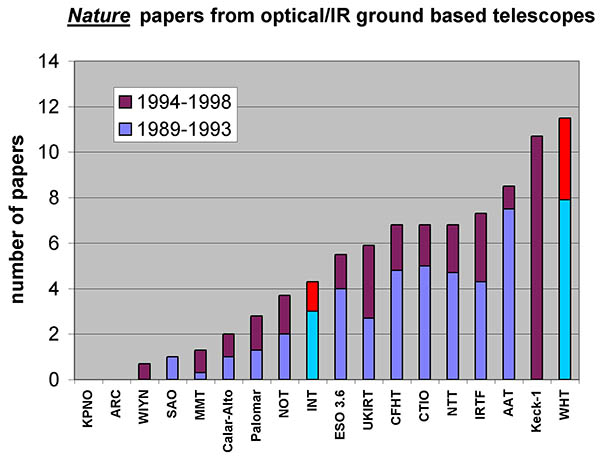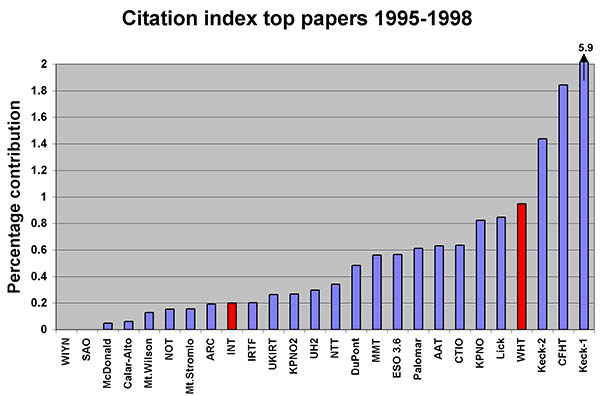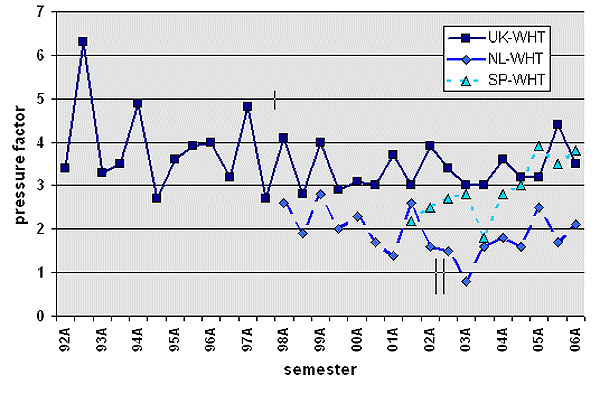ING currently receives its funding from the UK Particle Physics and Astronomy Research Council (PPARC), the Netherlands Organization for Scientific Research (NWO), and the Spanish Instituto de Astrofísica de Canarias (IAC). PPARC has indicated its intention to significantly reduce funding from 2009 onwards. To safeguard the scientific future of the ING a new balance of financial contributions between the partners in ING is being discussed, while new interested parties are on the horizon. The funding agencies have expressed their commitment to work towards a continuing healthy future for the observatory.
In future years ING’s telescopes should be seen in a wider, European context. Coordination of national facilities will be a central theme for European astronomy in years to come. ING is playing an active role in this, and is seeking to build bridges to other telescope groups at the Roque de los Muchachos Observatory. Finding common areas of interest and avoiding duplication will allow telescopes to work more cost effectively while still retaining the variety of instrument capability that the community demands.
The future scientific impact of the telescopes depends critically on the available instrumentation. Current instrumentation on the WHT caters well for a wide range of scientific projects. University-built, visiting instruments are expected to remain of scientific importance and are a uniquely attractive feature of the WHT. Ongoing instrument development activities focus on the completion of the laser guide star (LGS) upgrade to the adaptive optics (AO) system. This particular development activity is technically demanding, but the potential scientific reward is great: high-resolution IR imaging and optical integral-field spectroscopy over nearly the whole sky.
Building on ING’s experience and infrastructure in the field of adaptive optics and laser guide stars, and in collaboration with a large number of European institutes, ING is seeking European funding for the WHT to become an AO/LGS-technology test bed facility for future extremely large telescopes.
Looking towards the future, there are exciting new possibilities on the horizon. ING is negotiating the deployment of an extremely stable high-resolution spectrograph on the WHT. The prime objective of this instrument is in the hot-topic area of exo-planet searches, but the instrument will be available for other uses as well. This would satisfy a strong interest in our user community in high-resolution spectroscopy. Furthermore, to exploit the best observing conditions, expansion of service and queue-scheduled observing is anticipated, as far as future budget constraints will allow.
A number of smaller-scale but scientifically rewarding instrument developments are also in-hand. These include upgrades of CCDs, development of high-speed spectroscopic CCD modes, and the construction of an auxiliary port imaging camera, ACAM, that will allow high-quality imaging over a much wider field of view than currently available at the Cassegrain focus of the WHT. As ACAM will be virtually always available it will be a very useful tool for fast follow-up of transient sources or events, an activity that currently delivers an important science return.
Looking further ahead, ING plans to develop a new common-user instrument for the WHT that would fulfil the science requirements for future years. Also a new scientific role for the INT needs to be defined. We invite members of the community who are interested in working with us on the scientific direction and definition of a new instruments to contact us.
The Isaac Newton Group of telescopes has shown in past years its resilience and ability to adapt to new challenges. In coming years we will continue to strive to give the best possible service to the community.
René Rutten
rgmr@ing.iac.es
Director, ING
31 January 2007
Instrumentation Developments
for the William Herschel Telescope
The international landscape in which ING operates is also changing. First of all, Spain joined the ING as a full partner, contributing to the operating cost and instrument developments of the observatory, in return for a larger fraction of the observing time. Secondly, international collaborations between European observatories are being discussed and will likely become an important feature for the ING. The successful scheme of time sharing between the Italian Telescopio Nazionale Galileo and the WHT is one example of such collaboration. Wider collaborations are being discussed within the OPTICON EU collaboration. Within this framework the competitiveness of the telescopes have to be defined.
ING has identified a number of key areas of instrument development which allow the observatory to continue to offer an attractive and affordable service to its user community. This framework is briefly outlined here.
The current set of instruments on the William Herschel Telescope has been developed over a period of nearly two decades. The WHT supports four workhorse spectroscopic and imaging instruments: the ISIS medium resolution spectrograph, the LIRIS near IR spectrograph, the Prime Focus imaging unit, and the AUTOFIB/WYFFOS multi-object spectrograph. Availability of the LIRIS spectrograph, built at the IAC, has resulted from the new collaboration with Spain. Besides these instruments the WHT also offers adaptive optics capability, covering near IR imaging (INGRID), optical integral field spectroscopy (OASIS), and coronography (OSCA).
Furthermore, the WHT serves as a popular platform for visiting instruments such as the SAURON intergral field spectrograph, the PNS Planetary Nebula Spectrograph, the tripple-beam high-speed camera ULTRACAM, the SCAM super conducting tunnel junction detector, and most recently the CIRPASS fibre-fed IR spectrograph and the extremely high-accuracy polarimeter PLANETPOL. Also in the future it is foreseen that visiting instruments will be a recurrent feature at the observatory
The main areas of development of new common-user instruments and enhancement of existing instruments focus on adaptive optics in order to maximally exploit the good seeing at the observatory on La Palma. The existing AO instrument suite offers unique scientific capability of high spatial resolution spectroscopy in the visible wavelength range. The fraction of sky available for natural guide star AO is however limited to around only one percent, thus hampering wide application of AO observations. For reason of resolving the above limitation on sky coverage, in 2004 a project was started to construct a Rayleigh laser beacon for the WHT AO instrumentation. The system, once completed, will really open the field of high spatial resolution imaging and spectroscopy. Moreover, this development on the WHT will complement instrumentation at larger telescopes, allow high-resolution surveys to be carried out.

The ING finds itself at an important crossroads for various reasons. A number of major changes have taken place in recent years. For example, measures were introduced to drastically reduce the overall operational cost of the telescopes. Furthermore, developments around the world on large telescopes have resulted in changes in the requirements for the ING telescopes from the user community. And on the organisational side, the international agreements that have formed the basis of the scientific partnership on La Palma for a quarter of a century are up for renewal in the near future. These issues formed the core of the questions on which the visiting committee in 2005 was asked to provide its opinion. The review committee was chaired by Professor Jeremy Mould (National Optical Astronomy Observatory) with Professor Brian Boyle (Commonwealth Scientific and Industrial Research Organisation), professor Bruce Carney (Univ. of North Carolina) and professor Bruno Leibundgut (European Southern Observatory) as members. The report of the committee provides a positive and realistic outlook on the future of the ING. It highlights the scientific potential of in particular the 4.2-m William Herschel Telescope and provides support for the current development focus. ING's aim to seek further collaboration with other telescopes in order to provide a better overall service at lower cost is also seen as an appropriate way forward.
The full report can be found here, while information about earlier reviews can be found here.
Impact of Cost Savings at the Isaac Newton Group of Telescopes
It has been apparent for some time that the annual operating budget for ING would come under pressure, in particular as the UK has to free up funds to contribute towards the annual cost of joining ESO. Over the past year plans have been developed on how ING could be operated at a reduced budget. The decision from PPARC Council is in line with these plans. The key elements of the changes that these plans entail is presented here.
Probably the most important change is presented by the fact that the Instituto de Astrofísica de Canarias will become a full partner in ING as of 2002. An agreement was reached, with strong support from the ING Board and the UK and NL funding agencies, on the terms under which the IAC would join in the operating costs of ING. This agreement significantly alleviates the impact of the budget reductions announced by PPARC and allows ING to remain a strong a vibrant organisation that can deliver quality service to its user community.
The tight collaboration with the IAC is of strategic importance as this institute fulfills a pivotal role in the development of the observatory site, in particular with the construction of the 10-m GRANTECAN and its plans to create a European collaboration for observing facilities in the Northern hemisphere. Moreover, the IAC is developing a new observatory centre at sea level on La Palma, in which the ING will participate.
But nevertheless, the future budget available to ING for the operation of the telescopes will reduce by more than 30%, in spite of the additional contribution of the IAC. The IAC's contribution will commence in 2002, and the Netherlands will leave its annual contribution largely unchanged. This large decrease in the operational budget and the change of balance between the international partners implies a number of important changes, that can be summarised as follows:
1. Balance of observing time:
The balance of observing time will gradual change over the following
years. The agreed percentage breakdown of observing time will be as follows:
| 2001 | 2002 | 2003 | 2004 | 2005-9 | |
|---|---|---|---|---|---|
| UK | 60.0 | 54.0 | 50.0 | 48.9 | 47.6 |
| NL | 15.0 | 15.0 | 15.9 | 17.0 | 18.3 |
| CAT Spanish additional time | 0.0 | 6.0 | 9.1 | 9.1 | 9.1 |
| CAT Spanish time | 20.0 | 20.0 | 20.0 | 20.0 | 20.0 |
| CCI International time | 5.0 | 5.0 | 5.0 | 5.0 | 5.0 |
2. Service observations:
The existing scheme of service observations that are carried out by
observatory personnel will be discontinued on the JKT from the end of
semester 02A and on the INT from the end of semester 03A.
On the WHT service observation will remain available.
3. Use of the JKT and INT:
The JKT will be taken out of normal service as of September 2003.
Possibly this telescope will continue as a special-purpose telescope
with external funding. But if no additional resources can be found
the JKT will close.
It is the intention to review the longer term future of the INT before the end of 2004. By that time various other telescopes will be carrying out imaging surveys and the Liverpool telescope will be well established, making it timely to review the scientific use of the INT. Until that time, operation of the INT will have to be carried out at a lower cost. Cost saving measures envisaged are to operate the INT with only the Wide Field Camera from some time in 2003, and at the same time fully withdraw telescope operator support from that telescope.
4. Use of the WHT:
The focus of support and development will shift
fully towards the WHT in order to keep that telescope as attractive
as possible to the community. Although scheduling flexibility and
instrument changes may have to be more strictly limited, the
service delivered will be enhanced through the introduction of
queue observing mode for up to 30% of the time on the WHT. Primarily
queue observing will focus on adaptive optics observations.
5. A common-user IR imager and spectrograph
As part of the agreement with the IAC, the LIRIS IR
imager and spectrograph that is currently being developed at the IAC
will be made available to the general user community for at least 3
years after commissioning and acceptance. Commissioning of LIRIS
is anticipated to take place at the end of 2002. Given the popularity
of ING's IR imager, we expect that this new instrument will attract
much interest from the user community.
The changes mentioned above focus on the impact that the budget reductions will have on the use of the telescopes. Not mentioned here are the complex internal changes and cost saving measures in the way ING operates that will be implemented. It is our intention to minimize the disruption to normal day-to-day operation of the telescopes as much as possible, and ING remain dedicated to deliver the best possible service to our user community.
René Rutten
rgmr@ing.iac.es
Director, ING
21 December 2001
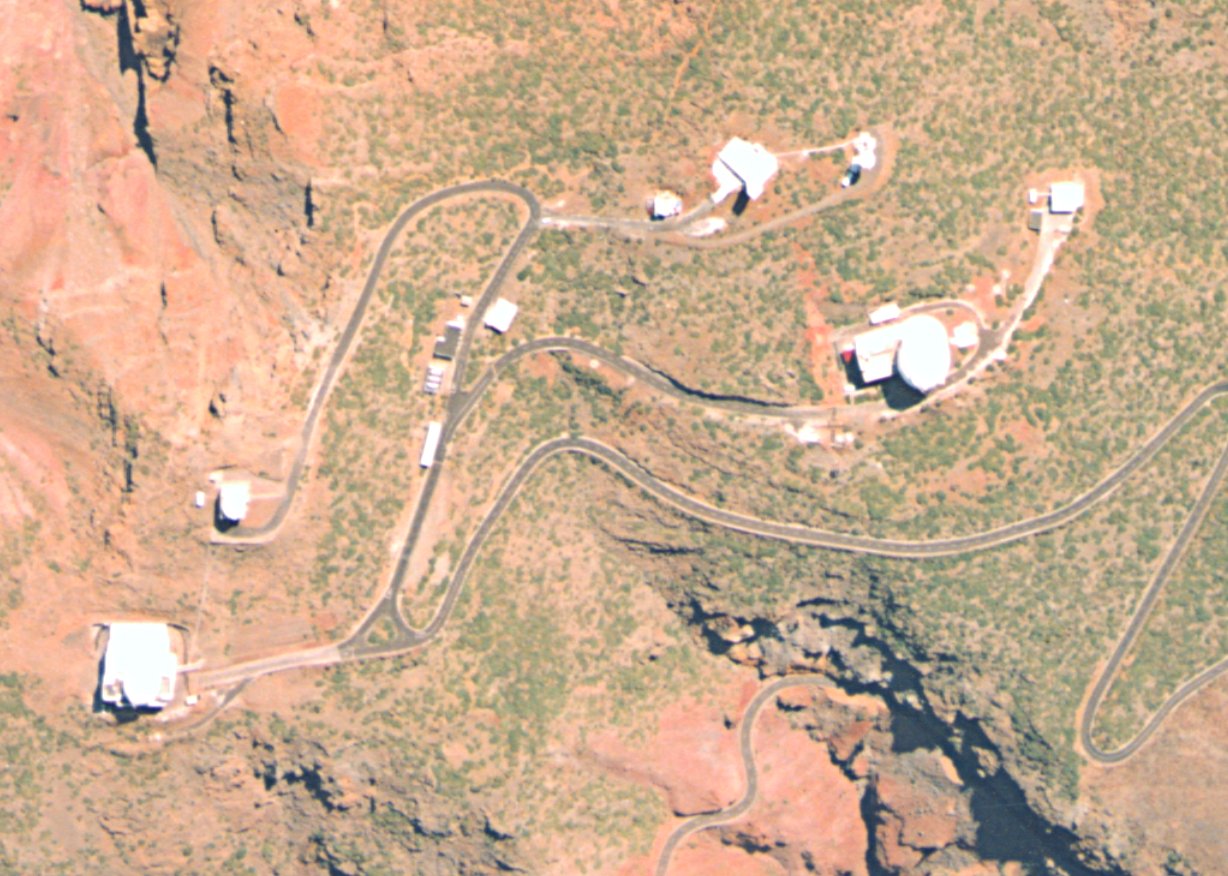
Highlights of Scientific Productivity

The following graph compares the number of papers published by various facilities as a function of time since original commissioning.
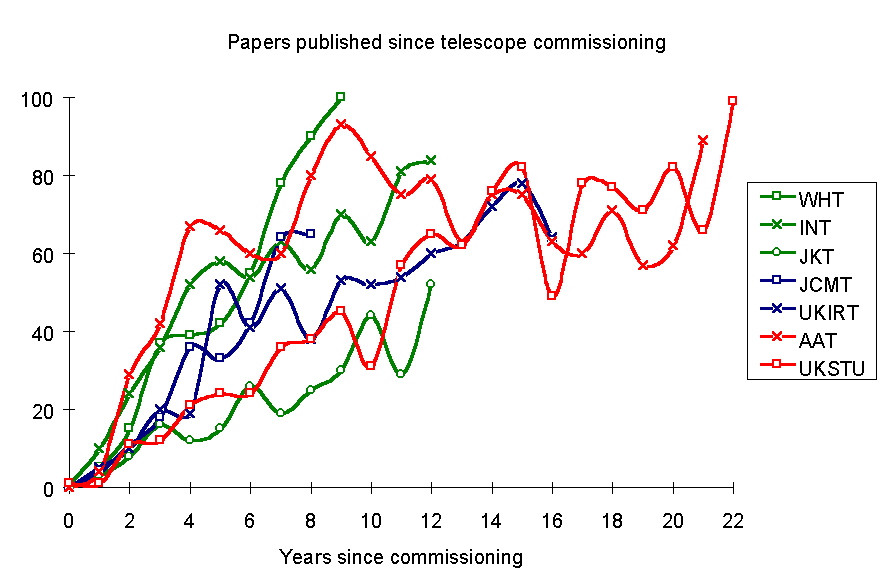
The high productivity of INGs telescopes is also indicated by a study comparing the scientific impact of ground-based optical/IR telescopes, as indicated by the number of papers published in Nature (Benn et al). The advantage of this measure is that it is relatively free from regional bias, and the time delay between discovery and publication is short. The graph below shows the result over the 10 years up till 1998 for the ING telescopes compared with large telescopes elsewhere that have been in operation for a number of years. The sample includes all telescopes with an aperture larger than 3.5-m, plus the Nordic Optical Telescope, the INT and the JKT. (Papers with contributions from more than one telescope are divided equally between those facilities). Clearly the WHT compares very favourably with other telescopes.
Citation studies demonstrate that the ING telescopes have a substantial impact on world astronomy. The most recent citation study (Benn et al.) shows the fractional contribution to the 125 most cited papers each year of all optical/IR ground-based telescopes. Figures are averaged over a period from 1995 to 1998. This graph shows that the WHT and INT are amongst the telescopes with the highest science impact in their class, the WHT being only rivalled by the Keck Telescopes and CFHT.
The oversubscription rate is another measure of whether the telescopes are fulfilling the needs of the user community. The graph below shows the historic development of the oversubscription statistics for the WHT.
Reports to the ING Board
During the May 2000 meeting in Leiden the ING Board agreed the term
for Guaranteed Observing Time for Instrument Builders.
Membership of the Visiting Group was as follows: The report from the Visiting Group was extremely positive about the way the observatory has developed in recent years, and was supportive of the development strategy for the William Herschel Telescope. The Visiting Group also emphasised the good possibilities that exist to build a wider collaboration on the excellence of the William Herschel Telescope and the La Palma observatory site. The Executive Summary of the report is available, as well as the response from the ING Board. Before the above review, in April 1998, on invitation from the UK/NL Joint Steering Committee, a Visiting Panel reviewed the operation, competitiveness, effectiveness, and future direction of the ING. The panel consisted of Dr. Russell Cannon (Chair, Anglo-Australian Observatory), Prof. Marijn Franx (University of Leiden), Prof. Ken Freeman (Mount Stromlo and Siding Spring Observatories), Dr. Augustus Oemler (Carnegie Institution of Washington), and Dr. Richard Wade (Rutherford Appleton Laboratories). The summary of the panel's report, and the response from the UK/NL Joint Steering Committee can be seen here. The report from the Visiting Panel provides a valuable, independent
assessment of the current state of ING. It provides an overall favourable
impression of ING, and suggests avenues for further improvement and direction
in the era of the very large telescopes.
|
